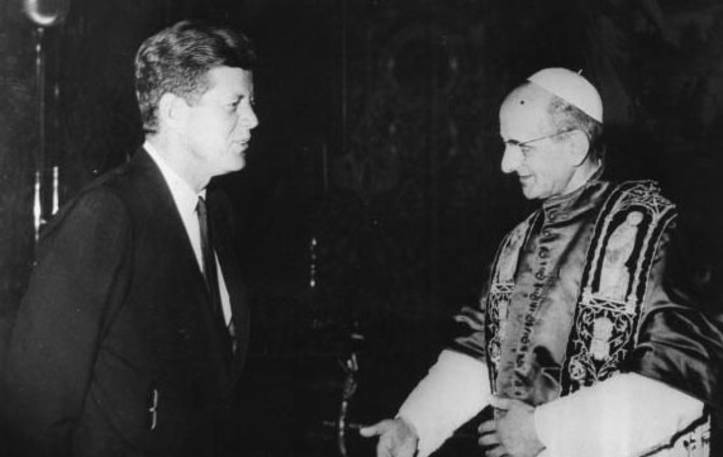


In connection with George W.Bush’s trip to Italy, we continue to look back at past Presidential visits to the Bel Paese. It was in 1963, in the very first days of July, that President John F. Kennedy went to Rome and Naples.
Kennedy’s trip to Italy is often forgotten and snubbed. It was simply the last stop in a larger and extremely famous tour of Europe that took the President to several Irish locations – producing the triumphal popular acclamation, “their Irish President” – and to West Berlin, where on June 26 he pronounced at the Rudolph Wilde Platz the oft-heard, often referenced “ich bin ein Berliner” speech. Well, let’s get two things straight about this speech before moving on to the neglected stop in Italy. First of all, there seems to be a sort of Italian influence in this famous speech. In fact, the catchy “ich bin ein Berliner” sentence is nothing more than President Kennedy’s modern version of the proud Ancient Roman boast “civis Romanus sum”. Second, setting aside the slogan, the best part of that speech was when the President said that “freedom has many difficulties and democracy is not perfect, but we have never had to put a wall up to keep our people in, to prevent them from leaving us”. Too often, just like the trip to Italy, this wonderful passage is forgotten.
Kennedy arrived in Italy on June 30. He privately stopped by Lake Como to avoid arriving in Rome during the coronation of Pope Paul VI. The following day he travelled to the Italian capital. No particular arrangements were made to greet President Kennedy. A small number of enthusiastic well-wishers gathered upon his arrival, but there were no noteworthy manifestations of support registered in Rome. A respectable number of people waited for the President’s passage in Via dei Fori Imperiali in front of the Colosseum, but nothing even close to the shows of spontaneous joy registered at the beginning of the century for Teddy Roosevelt or Woodrow Wilson. Kennedy’s main mission in Italy was to garner support for the deployment of a nuclear-armed fleet staffed by people from many nations in the European seas. With regard to this initiative, he Italian government was rather cold and sceptical.
The President met with Italian Prime Minister Giovanni Leone and with Italian President Antonio Segni. He also had the opportunity to chat with several other important political leaders, including Amintore Fanfani, Aldo Moro and a twenty-minute talk with Socialist leader Pietro Nenni. There was a high-tension moment when, during a reception, Kennedy met Palmiro Togliatti, leader of the Italian Communist Party. The President’s only words to Togliatti were “it’s nice to be in your country”. Speaking of tension, some of the closest members of the President’s staff felt the full brunt of the Italian government’s tepid reception. McGeorge Bundy and Theodore Sorensen were blocked and shoved by Italian police officers at the entrance of the Quirinal Palace, raising a minor quarrel between the Italian and the American protocol officers.
On June 2 the first and only Catholic President of the United States met with the freshly-crowned Pope Paul VI. The meeting was private and cordial. The same day he went to Naples to visit the AFSOUTH NATO Headquarters. Kennedy’s reception in the paese d’o Sole was completely different from the one in Rome. There people were really excited about the President’s presence. According to an article by Tom Wicker, published by the New York Times on July 3, 1963, the President’s appearance in Naples was “a smashing success. This hot and humid Mediterranean city gave the president one of the wildest receptions of his tour and provided a fitting climax to it”. That same day, another Times article attributed this warm and wonderful welcome to a theory that “most of the Neapolitans who cheered the President have relatives in the United States”.
President Kennedy’s visit in Naples left an indelible and significant mark, yet one more thing is often forgotten. His visit created the basis for a cooperation between the National Library of Naples, the United States Consulate General in Naples and the United States Information Service (USIS) that established a complete and extensive library about American history, politics and culture. For many years the U.S. government financed this vital cultural resource, today known as the “John F. Kennedy American Section” of the National Library of Naples. It is the only organic and organized resource in Southern Italy about many aspects of American culture, one of the very few places of its kind in Italy.
Getting back to our official Presidential scoreboard, it is clear that when it comes to the support of the Italian people, the Italian political elite and the Vatican, President Kennedy got 2 out of 3. Nevertheless he deserves an extra point for leaving behind a permanent cultural landmark, right in front of Mount Vesuvius.
Source URL: http://test.iitaly.org/magazine/focus/facts-stories/article/unforgettable-moments-forgotten-italy-meets-jfk
Links
[1] http://test.iitaly.org/files/kennedy1213744555jpg